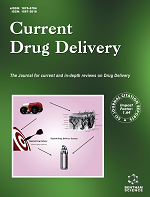- Home
- A-Z Publications
- Current Drug Delivery
- Previous Issues
- Volume 1, Issue 2, 2004
Current Drug Delivery - Volume 1, Issue 2, 2004
Volume 1, Issue 2, 2004
-
-
Studies on the Transdermal Delivery of Nimodipine from a Menthol-based TTS in Human Volunteers
More LessAuthors: Y. S.R. Krishnaiah and P. BhaskarThe purpose of the present study was to design a membrane-moderated transdermal therapeutic system (TTS) of nimodipine using 2%w / w hydroxypropyl methylcellulose (HPMC) gel as a reservoir system containing menthol as penetration enhancer and 60%v / v ethanol-water as solvent system. The flux of nimodipine was markedly increased from 35.51 μg / cm2 / h to 167.53±3.69 μg / cm2 / h with the addition of 8%w / Read More
-
-
-
Alkaline Hydrolysis as a Tool to Determine the Association form of Indomethacin in Nanocapsules Prepared with Poly(ε-Caprolactone)
More LessTo determine the association form of indomethacin in nanocapsules prepared with poly(ε-caprolactone) as polymer and a triglyceride as oil, two methods were studied. The indomethacin ethyl ester was prepared as control, which showed a higher affinity for the oil than the indomethacin. Two differently loaded nanocapsule formulations were prepared. For both formulations, a burst effect was detected using ethanol as release Read More
-
-
-
Influence of The Monomers Type on the Morphology of Polyamide Microcapsules
More LessAuthors: Abohachem Laguecir, Mohamed R. Louhaichi and Michel BurgardVarious polyamide microcapsules were prepared via an inverse emulsion system (water in oil) by interfacial polycondensation of terephthaloyl dichloride with the aliphatic diamines ethylene diamine (EDA) and 1,6-hexane diamine (HMDA), and the aromatic diamine 1,4-phenylene diamine (PDA). Three types of polyamide microcapsules were thus obtained and labeled: CAPS EDA, CAPS HMDA, and CAPS PDA, respectively. Th Read More
-
-
-
A New N-Acetylgalactosamine Containing Peptide as a Targeting Vehicle for Mammalian Hepatocytes Via Asialoglycoprotein Receptor Endocytosis
More LessGalactoside-containing cluster ligands have high affinity for asialoglycoprotein receptors (ASGP-r), which are found in abundance in mammalian parenchymal liver cells. These ligands may be conjugated with a therapeutic drug to improve the efficiency of delivery to diseased liver cells. This report describes a new synthetic route towards clustering glycopeptides containing N-acetyl-D-galactosamine (GalNAc). The building blo Read More
-
-
-
Human Vaginal Mucosa as a Model of Buccal Mucosa for In Vitro Permeability Studies: An Overview
More LessAuthors: Pieter v. d. Bijl and Armorel D. van EykThe buccal cavity is attractive for noninvasive, controlled transmucosal delivery of both local and systemic therapeutically active compounds. Administering drugs via this route is advantageous due to the rich vasculature of the oral mucosa, and the absence of gastrointestinal and “first-pass” hepatic degradation. Moreover, the barrier properties of the oral mucosa against noxious substances and its role in disease requir Read More
-
-
-
Passive and Iontophoretic Controlled Delivery of Salmon Calcitonin Through Artificial Membranes
More LessAuthors: D. F. Stamatialis, H. H.M. Rolevink and G. H. KoopsThe development of a transdermal delivery system for drug molecules of high molecular weight (peptides or proteins) is nowadays a great scientific and commercial challenge. For these molecules, the passive transport through the skin is generally very low and should be enhanced by the application of the electrical current (a method called iontophoresis). A very important component of a transdermal iontophoretic sys Read More
-
-
-
Phospholipid Vesicles as Carriers in Aquaculture: Preparation and Stability Study of Thiamine Hydrochloride-Loaded Liposomes
More LessAuthors: Francesco Lai, Donatella Valenti, Chiara Sinico, Maria Manconi, Jose B. Mendez and Anna Maria FaddaThe aim of this work is to study liposomes as carriers of nutrients and therapeutic agents in aquaculture with Venerupis decussatus and Venerupis pullastra larvae. Multilamellar (MLVs) and large unilamellar (LUVs) vesicles were prepared from a commercial mixture of soy phosphatidylcholine, rich in unsaturated and polyunsaturated fatty acids, cholesterol, and hydrated with a solution of vitamin B1 both in distilled and sea wate Read More
-
-
-
A New Gene Delivery System Based on Controlled Release Technology
More LessAuthors: Toshihiro Kushibiki and Yasuhiko TabataThe recent rapid development of molecular biology together with the steady progress of genome projects has given us some essential and revolutionary informations of gene to elucidate all the biological phenomena at the molecular level. Under these circumstances, gene transfection has become a fundamental technology indispensable to the basic research of medicine and biology. On the other hand, the technology Read More
-
-
-
Current Developments in Gene Transfection Agents
More LessAuthors: Tony Azzam and Abraham J. DombDNA can be delivered into the cell nucleus either using physical means or specific carriers that carry the genes into the cells for gene expression). Various carriers for delivering genes have been investigated which can be divided into two main groups: viral carriers where the DNA to be delivered is inserted into a virus, and cationic molecular carriers that form electrostatic interactions with DNA). Successful gene therapy Read More
-
Volumes & issues
-
Volume 22 (2025)
-
Volume 21 (2024)
-
Volume 20 (2023)
-
Volume 19 (2022)
-
Volume 18 (2021)
-
Volume 17 (2020)
-
Volume 16 (2019)
-
Volume 15 (2018)
-
Volume 14 (2017)
-
Volume 13 (2016)
-
Volume 12 (2015)
-
Volume 11 (2014)
-
Volume 10 (2013)
-
Volume 9 (2012)
-
Volume 8 (2011)
-
Volume 7 (2010)
-
Volume 6 (2009)
-
Volume 5 (2008)
-
Volume 4 (2007)
-
Volume 3 (2006)
-
Volume 2 (2005)
-
Volume 1 (2004)
Most Read This Month
Article
content/journals/cdd
Journal
10
5
false
en

Most Cited Most Cited RSS feed
-
-
Preface
Authors: Deng-Guang Yu and He Lv
-
- More Less

